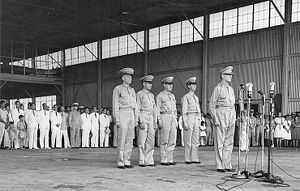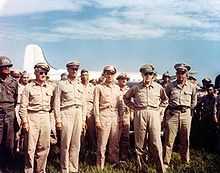Richard K. Sutherland
| Richard Kerens Sutherland | |
|---|---|
 | |
| Born |
November 27, 1893 Hancock, Maryland |
| Died |
25 June 1966 (aged 72) Washington, D.C. |
| Buried at | Arlington National Cemetery |
| Allegiance |
|
| Service/branch |
|
| Years of service | 1916 – 1946 |
| Rank |
|
| Battles/wars |
Pancho Villa Expedition World War I World War II |
| Awards |
Distinguished Service Cross (2) Distinguished Service Medal (2) Silver Star (2) |
| Relations | Son of US Senator Howard Sutherland (West Virginia) |
Richard Kerens Sutherland (27 November 1893 – 25 June 1966) was a Lieutenant General of the US Army and General of the Army Douglas MacArthur's Chief of Staff in the South West Pacific Area during World War II.
Early life
Sutherland was born in Hancock, Maryland on 27 November 1893, the only son among the six children of Howard Sutherland, who later became a US Senator from West Virginia, and Etfie Harris Sutherland.[1]
He was educated at Davis and Elkins College, Phillips Academy, from which he graduated in 1911, and Yale University, graduating with a Bachelor of Arts in 1916.[2]
While at Yale, he joined the Reserve Officer Training Corps. In 1916, he enlisted as a private in the Connecticut National Guard.[2]
Great War
Later that year the National Guard was federalized and he served on the Mexican Border during the Pancho Villa Expedition. The future general soon accepted a National Guard commission as a second lieutenant in the field artillery. Soon after, he transferred to the Regular Army with a commission in the infantry. He was promoted to captain in 1917.[2]
He served with the 2nd Division on the Western Front during World War I. He was a student at a tank school in England.[3]
Between the wars

Returning to the United States, Sutherland married Josephine Whiteside in 1920. They had one child, a daughter named Natalie.[2]
Sutherland was an instructor at the United States Army Infantry School from 1920 to 1923 and professor of military science and tactics at the Shattuck School from 1923 to 1928. He graduated from the Command and General Staff College in 1928. Fluent in French, he attended the École supérieure de guerre in 1930. From 1932 and 1933 he attended the U.S. Army War College. He then served with the Operations and Training Division of the War Department General Staff.[4]
In 1937 he went to Tientsin, China, in command of a battalion of the 15th Infantry; however, he was not promoted to major until March 1938, when he was assigned to the Office of the Military Advisor to the Commonwealth Government (Philippines), Manila, under General Douglas MacArthur with the "local rank" of lieutenant colonel. He was promoted to the rank in July of that year. Sutherland soon eased his superior, Lieutenant Colonel Dwight D. Eisenhower out of his position and became MacArthur's chief of staff.[2]
World War II

As tensions with Japan rose, Sutherland was promoted to full colonel, then to brigadier general in July 1941 and major general in 1941.[4]
Following the fall of Manila, MacArthur's headquarters moved to the island fortress of Corregidor, where it was the target of numerous Japanese air raids, forcing the headquarters to move into the Malinta Tunnel. Sutherland was a frequent visitor to the front on Bataan. He was given a cash payment of $75,000 by President Quezon. In March 1942, MacArthur was ordered by President Franklin D. Roosevelt to relocate to Australia. Sutherland selected the group of advisers and subordinate military commanders that would accompany MacArthur and flee the Philippines in four PT boats. Sutherland would remain MacArthur's chief of staff for the entire war.[5]
Sutherland attracted antagonism from subordinate American and Australian officers because of perceptions that he was high-handed and overprotective of MacArthur. Sutherland was often given the role of "hatchet man". Bad news invariably came through Sutherland rather than from MacArthur himself.
According to some sources he contributed to a rift between MacArthur and the first SWPA air forces commander, Lieutenant General George Brett. Major General George Kenney, Brett's successor, became so frustrated with Sutherland in one meeting, that Kenney drew a dot on a plain page of paper and said: "the dot represents what you know about air operations, the entire rest of the paper what I know."[6]
Sutherland had been taught to fly in 1940 by US Army Air Corps instructors at the Philippine Army Training Center and had been awarded a civil pilot's licence by the Civil Aeronautics Association. Flying then became one of his favourite recreational activities and while in Australia he flew as frequently as possible. In March 1943 he asked to be formally recognised as a "service pilot", a form of pilot restricted to non-combat duties. His request was turned down by the Commanding General of the U.S. Army Air Forces, General Henry H. Arnold on the grounds that he was over the age limit and not performing flying duties. However, Sutherland secured an official pilot's rating under Philippine Army regulations in 1945.[7]
In 1943 Sutherland and Kenney took part in an effort to promote General MacArthur's candidacy for the Presidency, working with Senator Arthur H. Vandenberg of Michigan to get the War Department to rescind the order that prevented MacArthur from seeking or accepting political office.[1]

It was Sutherland who represented MacArthur before the Joint Chiefs of Staff on this and other occasions. Sutherland opened, read, and frequently answered all communications with MacArthur, including those addressed to him personally or "eyes only". Some decisions often attributed to MacArthur were actually taken by Sutherland. For example, the decision to bypass Mindanao and move on directly to Leyte was taken by Sutherland on MacArthur's behalf, while MacArthur was traveling under radio silence.
When MacArthur discovered that Eisenhower had promoted his chief of staff, Walter Bedell Smith, to the rank of lieutenant general in January 1944, he immediately arranged for Sutherland to be promoted to the same rank.
Affair with Elaine Clarke
During the time while MacArthur's GHQ SWPA was located in Melbourne, Sutherland met Elaine Clarke, a socialite whose husband, a British Army officer, was a prisoner of war in Singapore. When GHQ moved to Brisbane in July 1942, Clarke moved with it, as did two other civilian women who worked as secretaries for Generals Kenney and Richard Marshall. Sutherland installed Clarke as the receptionist at the AMP Building, where MacArthur had his headquarters.[8]
When GHQ began planning to move forward to New Guinea, Sutherland requested personnel from the Women's Army Corps to replace civilian employees of GHQ who, by agreement between General MacArthur and the Prime Minister of Australia, John Curtin, could not be sent outside Australia. Sutherland further asked for direct commissions for Clarke and Kenney's and Marshall's secretaries. This exploited a loophole whereby enlistments in the Women's Army Corps were restricted to American citizens, but officer commissions were not. Major General Miller G. White, the U. S. Army Deputy Chief of Staff for Personnel, and Colonel Oveta Culp Hobby, the commanding officer of the Women's Army Corps, were strongly opposed; but they were overruled by Deputy Chief of Staff Joseph T. McNarney, on his being informed that the commissions were personally desired by General MacArthur as essential to the operation of his headquarters and the prosecution of the war. Clarke was commissioned as a captain, as was General Eisenhower's driver, Kay Summersby, while the other two women were commissioned as first lieutenants.[9]
Although her rank was more a reflection of Sutherland's status rather than her own, Clarke became an assistant to the headquarters commandant, with duties commensurate with her rank, and moved with Advance GHQ to Hollandia. However, her presence there in contravention of his agreement with Curtin ultimately brought down the displeasure of General MacArthur, who ordered her to be returned to Australia, first from Hollandia, and later from the Philippines. That Sutherland defied MacArthur on this matter caused a rift between the two.[10]
Japanese surrender

At the Japanese surrender in Tokyo Bay on September 2, 1945, the Canadian representative, Colonel L. Moore Cosgrave, signed the Japanese Instrument of Surrender underneath, instead of on, the line for Canada. The Japanese drew attention to the error. Sutherland leaned over the table and ran two strokes of his pen through the names of the four countries above the misplaced signatures and wrote them in where they belonged. The Japanese then accepted the corrected document.[11]
Later life
Sutherland retired from the Army shortly after the Japanese surrender.
Returning home, he confessed his affair to Josephine and was ultimately reconciled with her. Letters from Clarke were intercepted and destroyed by Natalie.[12]
After the death of Josephine on 30 December 1957, he married Virginia Shaw Root in 1962.[1]
Sutherland died at Walter Reed Army Medical Center on 25 June 1966. His funeral was held at the Fort Myer, Virginia chapel on 29 June 1966 and he is buried at Arlington National Cemetery along with other family members.[1]
Decorations
| Distinguished Service Cross with Oak Leaf Cluster | |
| Army Distinguished Service Medal with Oak Leaf Cluster | |
| Silver Star with Oak Leaf Cluster | |
| Mexican Border Service Medal | |
| World War I Victory Medal with two battle clasps | |
| American Defense Service Medal with Foreign Service Clasp | |
| Asiatic-Pacific Campaign Medal with four Service Stars | |
| World War II Victory Medal | |
| Army of Occupation Medal | |
| Companion of the Order of the Bath (United Kingdom) | |
| Distinguished Service Star (Philippines) | |
| Philippine Liberation Medal with two bronze stars |
See also
References
- ↑ 1.0 1.1 1.2 1.3 Arlington Cemetery Site
- ↑ 2.0 2.1 2.2 2.3 2.4 Rogers, Paul P. (1990). MacArthur and Sutherland: The Good Years. New York City: Praeger. pp. 36–39. ISBN 0-275-92918-3.
- ↑ "Man Behind MacArthur". TIME (Time (magazine)). 7 December 1942
- ↑ 4.0 4.1 Ancell, R. Manning; Miller, Christine (1996). The Biographical Dictionary of World War II Generals and Flag Officers: The US Armed Forces. Westport, Connecticut: Greenwood Press. p. 313. ISBN 0-313-29546-8
- ↑ Rogers, The Good Years, pp. 120-121, 128-130, 165, 189
- ↑ Wolk, Herman S. (April 2002). "The Genius of George Kenney". Air Force Magazine Online 85 (4)
- ↑ Griffith, Thomas E., Jr (1998). MacArthur's Airman: General George C. Kenney and the war in the Southwest Pacific. Lawrence, Kansas: University Press of Kansas. pp. 67–68, 272–273. ISBN 0-7006-0909-1.
- ↑ Rogers, Paul P. (1991). MacArthur and Sutherland: The Bitter Years. New York City: Praeger. pp. 65–66. ISBN 0-275-92919-1.
- ↑ Treadwell, Mattie E. (1991) [1954]. United States Army in World War II: Special Studies: The Women's Army Corps. Washington, D.C.: United States Army Center of Military History. pp. 393, 413–414. CMH Pub 11-8.
- ↑ Rogers, The Bitter Years, pp. 68-69, 236-237
- ↑ "... Peace Be Now Restored". TIME (Time (magazine)). 10 September 1945
- ↑ Rogers, The Bitter Years, p. 306